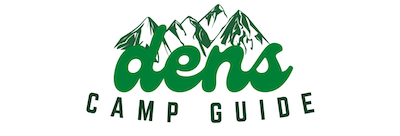Do you plan to cook your meals over your campfire? Great! How hot is the average campfire? A well-constructed campfire can reach temperatures of 900degC!
In this guide you’ll find out the typical and average campfire temperature (3 measures) and the variables that influence the temperature. Additionally, you’ll learn about the metals you must be concerned about melting when you’re on the campfire.
There are many variables that affect the temperatures of campfires which we’ll explore. Here’s the quick answer.
How Hot Can A Campfire Get?
There are two temperatures you should be aware of.
- Internal Temperature: A campfire may achieve temperature levels of 1650 degrees Fahrenheit (900degC) in flames, referred to as the continuous flame area.
- The Cooking temperature: Beyond the fires (called”thermal plume regions) in which no flames are visible, it is possible to expect temperatures to be around 600degF (320degC). It’s where you’ll be doing the cooking. The further you are away from flames, the more away from the flames, the lower the temperature.
Large campfires (like bonfires) can be even more hot – up to 2500degF (1100degC). Of course, you’re not likely to cook at the full scale of a bonfire…
Campfires are warm enough to melt an aluminum container but not a cast iron fry pan.
Most likely, you’ve witnessed the effects on a soda bottle (aluminum alloy) when it’s placed in the flame. It melts and disappears completely except for the parts on the bottom and top of the bottle.
Only build a campfire that you can easily contain safely, and make sure to extinguish the campfire correctly before you leave. Do not leave a fire going, either put it out or wait until it dies completely by itself.
How Hot Is The Average Campfire Melting Points?
Here are some common metal melting points to help you compare.
- Aluminum: 1220degF (660degC)
- Aluminium Alloy: 865-1240degF (463-671degC) The melting point varies on the alloy’s type.
- Cast Iron: 2060degF (1127degC)
- Stainless Steel: 2750degF (1510degC)
Be cautious! Many camping cooking tools are made from aluminum, which can melt if they fall into the fire. It might be best to use stainless steel so that at least you’ll be able to reuse it … after it cools off.
A few camping cookwares are constructed of aluminum. Be sure to keep it away from burning flames so it won’t harm the pot.
The color of the flame is a sign of the temperature. Red signifies cooler temperatures, while blue indicates much higher temperatures. White flames show the most intense flames.
How Hot Does A Campfire Burn?
As with all fires, the temperature will fluctuate based on various factors.
- Fuel type: kind of wood (softwood or hardwood and/or resinous) as well as its degree of dryness (seasoned or green).
- The size of fire: the quantity of fuel used will determine how hot the flame can become.
- Oxygen flow: A campfire in a steel fire pit will not become as hot as one with a constant oxygen supply (light breeze or a pair bellows).
There are three components to a successful fire: air, fuel, and heat. A huge, fast-burning fire with a lot of fuel will burn hotter than a well-maintained fire that is the ideal one to cook on.
3 Ingredients To A Good Fire
Let’s look at how to make the fire. Three things are required:
- Kindling: Tiny twigs and dry leaves that quickly catch fire and produce heat that can start large pieces of timber burning. Paper, cardboard, and fire-starters also serve as the tinder.
- Sorting: The smaller pieces of wood that can ignite faster than the logs you place on the top. These could be larger and thicker twigs, smaller branches, or slivers from the primary fuel cut-off larger logs. They will begin to produce coals as they melt down, creating a solid basis for your flame.
- Fuel: It is usually the harder, larger wood on the top. It requires much more fire and heat to start going however, once they are, they’ll burn well and create the perfect cooking fire.
You require a uniform heat source to cook evenly as you would at home. Putting everything in all at once and then cooking the most flaming inferno can seem impressive but isn’t suitable to cook because it’s simply too hot!
An intense fire can attain temperatures of 1650 deg F (900degC) which is capable of melting aluminum, and it can eat away at the wood you have available quickly and even burn your food items.
To cook on your campfire, it is necessary to be able to heat up a bit before creating a solid base of coals.
Begin with kindling and tinder. The tinder will warm and then catch fire to the kindling, which, as it burns, will produce enough heat to heat your larger chunks of wood.
When burned down, they create a uniform heat base, similar to the stovetop. You can adjust temperatures by adding additional logs as you progress.
You only need to be aware of the kind of wood you choose to use. Older, dry wood is more prolonged and hotter than softwood (like pine) which burns faster.
Freshly cut or green wood is packed with sap but not dry enough, so it burns at less temperature. Ideally, you’ll need high-quality hardwood logs that will keep you going and be evenly burned.

